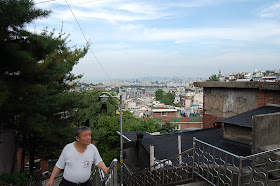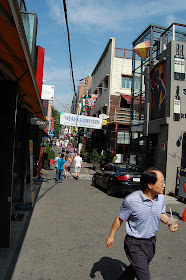As someone who grew up in the east end of London, one of the things I've found most striking about Korea is the high degree of uniformity between its people. Not in terms of social conformity - though one gets the sense that's also a pretty big thing here - but in terms of ethnicity and colour. Back home, I can spend ten minutes riding the London Underground and in that short time see commuters from all corners of the globe: Bangladeshis, Nigerians, Turks, Poles, Jamaicans, Filipinos, to name a few. Here, I can spend an hour on the Seoul Metro and not see a single non-Korean face the whole time. Despite centuries of interaction with other Asian countries, despite its global economy, its participation with the international community, and its recruitment of foreign workers in various sectors of its industry, Korea remains one of the most ethnically homogenous countries in the world.
Its foreign population is slowly growing, however, and in 2010 The Korean English-language newspaper, JoongAng Daily, discussed the role that multiculturalism may play in Korea's future:
"If you stay too long, Koreans become uncomfortable with you. [...] Having a 2 percent foreign population unquestionably causes ripples, but having one million temporary foreign residents does not make Korea a multicultural society. [...] In many ways, this homogeneity is one of Korea’s greatest strengths. Shared values create harmony. Sacrifice for the nation is a given. Difficult and painful political and economic initiatives are endured without discussion or debate. It is easy to anticipate the needs and behavior of others. It is the cornerstone that has helped Korea survive adversity. But there is a downside, too. [...] Koreans are immersed in their culture and are thus blind to its characteristics and quirks. Examples of group think are everywhere. Because Koreans share values and views, they support decisions even when they are obviously bad. Multiculturalism will introduce contrasting views and challenge existing assumptions. While it will undermine the homogeneity, it will enrich Koreans with a better understanding of themselves.
One place where you can easily envision a multicultural Korean society is Itaewon, a
dong (or city district) in central Seoul. It is the main international district in Seoul, and one of the few places in the city where foreigners are as common a sight as Koreans. This has been both a blessing and a curse for the area, for while outsiders have brought their vibrant colours, cultural innovations and diverse cuisines to the area, there's also a more run-down feeling to the area, and a somewhat seedy nightlife culture makes it feel occasionally unsafe in the evenings (something I can't say for anywhere else I've been to in Seoul). Plus, this many young western expats in one place is always going to breed some pretty obnoxious behaviour: one of the first things I saw, when I first visited the district, was a drunken white guy (possibly US military, since they're based here) parading in the street and mooning at taxi drivers. Behaviour of this sort is pretty par-for-course back home, at least in the cities on a saturday night, but you just don't see it from Koreans, who nearly always remain dignified regardless of how inebriated they might be.
I don't want to make it sound like a bad place though. Once you get past the drunken GI Joes and shabby streets, Itaewon is an exciting place to explore, a haven of great international cuisine, and a generally fun place to party. Here are some pictures I've taken of the area at various points during my year here.
 |
| The busy intersection just outside Itaewon Station. Most of the district's major landmarks are based on and around this main stretch of road. |
 |
| The streets of the main intersection are paved with these international tiles that pay tribute to different countries around the globe. |

 |
| Hamilton Hotel, one of the most well-recognised landmarks, and a popular meeting place in Itaewon. |
 |
| Though some parts of the district can feel run-down, there are also some rather pretty areas that make for pleasant wandering. |
 |
| There are also many hills, providing great views over the city. |
 |
| Because of the large foreign population in the area, there are a bunch of these international supermarkets selling all those goodies you've missed from back home... |
 |
| ...as well as many foreign oddities you'll never have seen before. Think I'll stick with the Cadbury's Dairy Milk this time! |
 |
| The district is home to a large muslim community, and some streets are dominated by Halal restaurants and supermarkets, as well as Islamic libraries and hijab stores. |
 |
| Seoul Central Mosque dominates the Islamic quarter, and is the largest mosque in Korea. |
 |
| Itaewon is so multicultural that there are "Foreigners Only" taxis that guarantee an English-speaking driver (not so common in taxis elsewhere in Korea!) |
 |
| The district is home to several US Army Bases, and in fact the main reason it became an international district is because of all the US soldiers who flooded into the area following the Korean War. |
 |
| Itaewon is also famous for being the centre of gay culture in Korea. Homosexuality is still a big taboo subject in Korean society, but it's gradually becoming more accepted, with annual Gay Pride parades and events taking place in the cities, and notable celebrities coming out to the public. The district is home to several gay bars, most notably along the stretch dubbed "Homo Hill," as well as "queer shelters" and male saunas like the one in the photo. |
 |
| Perhaps Itaewon's best gift to Seoul is its food. This international food street, which runs parallel with the main high street, hosts an array of restaurants representing different world cuisines: Indian, Italian, American, Brazilian, French, and even British (though I've yet to try that Sunday Roast I've been pining for over the last ten months)! |
 |
| Be warned: most of these international restaurants are on the pricey side. However, the food is nearly always worth the high cost, especially when you're tired of eating Korean barbecue all the time. |
 |
| Of the restaurants Angela and I have visited together, one of our favourites is Zelen. Located at the top of the steps in the photo, it specialises in Bulgarian food, something neither of us had tried before. It was heavenly. |
 |
| We also really enjoyed eating Greek cuisine at Santorini's, a restaurant on the main food street. |
 |
| Itaewon is also an attractive place for foreign shoppers, with its imported clothes markets, antique shops and English language bookstores. |
 |
| Exploring an alley market. |
 |
| And then we come to the nightlife. As I said before, this side of Itaewon can at times feel shady and unpleasant, but for the most part there are some really great bars and clubs around, and you're mostly safe as long as you don't go looking for trouble. |
 |
| Aicha, Angela and Sean hanging out in Scrooge's, a cool sports bar on the main food street. |
 |
| Angela sips a cocktail in Bungalow's. This is one of our favourite bars, since it replicates a tropical beach scene, complete with sand, candles and rope swings! |
 |
| Finally, after you've partied all night and your body needs some soothing R&R, you can always unwind in Itaewon Land, a jjimjilbang that Angela and I visited a while back and can vouch for. |
And that ends my brief overview of Itaewon, which for all its flaws remains one of my favourite areas in Seoul. While I'll always prefer to party somewhere like Hongdae or Gangnam, the food and the cultural-melting-pot-atmosphere (so unattainable elsewhere in this country) of Itaewon keeps me coming back for more.




























Looks like you've had a blast in Seoul.
ReplyDeleteexpatriate tax services
Interesting blog, it reminds me of Myeongdong Day Time , we can see faces of K-pop girl group Girl’s Generation, Blackpink, or boy group Exo , Super Junior on shirts as well as on stationeries, and also we can see traces of Winter Sonata, Autumn in My Heart, or My Sassy Girl on displays reminding us of the popular K- Dramas.
ReplyDeleteI tried to write a blog about it, hope you also like it https://stenote.blogspot.com/2019/11/seoul-at-myeongdong-day-time.html.